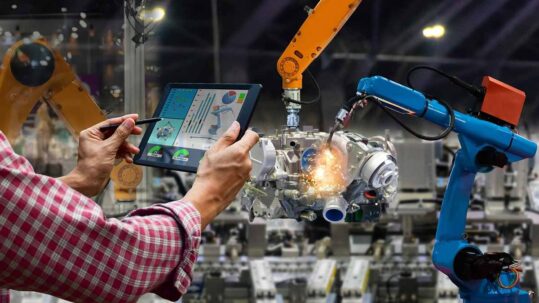
03 Apr Services in IoT, Industry 4.0, Automation & Control
Exploring the Services in IoT, Industry 4.0, Automation & Control, and Custom Solutions
Business operations have altered as a result of the introduction of digital transformation and technologies like IoT, Industrial 4.0, Automation & Control, and Custom Solutions. These innovations are opening the door for operations that are more productive, economical, and efficient. IoT technology enables communication between machines and devices, and Industry 4.0 makes use of data and IoT to enhance industrial operations. We use technology to automate processes under the heading of automation and control, and unique solutions. These can be created to satisfy unique business requirements. In this article, we’ll go into more detail about these services businesses can provide to companies across a range of industries.
Services in IoT
IoT technology has made it feasible to connect and “smarten” up a variety of machines and gadgets. Some of the services in IoT offered by are listed below:
- Custom product/solution development
- Hardware design
- Firmware development
- Embedded systems
- IoT integration and retrofitting
- Remote monitoring and control
- Asset tracking
- Fleet management
Let us now explore these services in detail:
Custom product/solution development: IoT solutions can be customized to meet specific business needs. For instance, a business might need an IoT system that can track and manage energy use in their manufacturing facility. To address this demand, a tailored solution can be created and applied, leading to lower energy expenditures and more effectiveness.
Hardware design: Hardware design involves creating and testing hardware that will support IoT technology. This involves creating the hardware needed for an IoT solution, such as sensors, gateways, and other hardware elements. An IoT project’s success depends on the hardware design, which guarantees that the solution is dependable and can operate in the desired environment.
Firmware development: Developing and evaluating software that will operate on the hardware is a part of firmware development. This software is in charge of gathering and analyzing information collected by the sensors and coordinating communications with other IoT solution components. A thorough grasp of the hardware and the result of specific of the IoT solution is necessary for firmware programming.
Embedded systems: Embedded systems are machines with processing power and the ability to carry out particular tasks. Home automation systems, intelligent door locks, and industrial automation are a few applications of embedded systems. Most IoT solutions must include embedded systems, which necessitate specialist knowledge in both software and hardware design.
IoT integration and retrofitting: Integrating IoT technology into already-in-use systems might be difficult. For instance, integrating IoT technology into an established manufacturing facility necessitates a thorough comprehension of both the facility’s current architecture and the precise needs of the Integrated process. Hardware design, programming, and systems engineering knowledge are required for IoT integration.
Remote monitoring and control: Remote monitoring entails keeping an eye on and managing systems from a distance. For instance, a business might utilize remote monitoring to monitor the operation of its inventory and other assets, such machinery. By detecting problems prior to them becoming significant, remote monitoring can assist businesses cut expenses and increase efficiency.
Asset tracking: Assets like machinery and stock may be tracked using IoT technology. Asset tracking minimizes the possibility of loss or theft by enabling organizations to follow the whereabouts and condition of their assets in real-time.
Fleet management: IoT technology has the potential to oversee driver conduct and control fleets of automobiles. For instance, a trucking business might utilize IoT technology to track the whereabouts of its trucks, keep an eye on fuel consumption, and plan out distribution networks. By maximizing the use of their resources, organizations can cut expenses and increase efficiency with the aid of transportation and logistics.

Services Included in Industry 4.0
Industry 4.0 refers to the use of IoT technology and data to improve industrial processes. Here are some of the services included in Industry 4.0:
- Smart inventory management
- Predictive maintenance
- Connected supply chain management
- Industrial remote monitoring
Let us now explore these services in detail:
Smart inventory management: Real-time inventory tracking with IoT technology can improve the supply chain and eliminate the requirement for manual managing inventory. Businesses can use this service to lower their inventory carrying expenses and avoid situations when there are stockouts or excess supplies. Businesses can watch the location and status of inventory in real-time with the help of IoT sensors, making it simpler to spot problems and implement fixes before they cause an interruption in the distribution network.
Predictive maintenance: Predictive maintenance is an Industry 4.0 service that leverages IoT technology to monitor equipment and predict when maintenance will be required. With predictive maintenance, businesses can reduce downtime, increase equipment lifespan, and improve safety. IoT sensors can be installed on machines to monitor their performance and detect potential issues before they escalate into major problems. By analyzing data from these sensors, businesses can predict when maintenance is required and schedule it at a convenient time to minimize disruption.
Connected supply chain management: IoT technology is capable of helping link the many components of a supply chain, improving communication as well as coordination. Businesses may enhance productivity, save costs, and optimize their supply chains with the aid of this service. Businesses can follow the shipment’s movement in real-time utilizing IoT sensors, making it simpler to spot bottlenecks and improve logistics. By giving real-time information into production levels and demands, integrated supply chain administration can also assist firms in lowering the risk of stockouts or overstocking problems.
Industrial remote monitoring: Industrial remote monitoring is an Industry 4.0 service that leverages IoT technology to monitor industrial processes remotely, reducing the need for on-site staff and improving efficiency. With industrial remote monitoring, businesses can monitor equipment performance and detect issues in real-time, improving the accuracy and speed of decision-making. By automating routine tasks and monitoring equipment remotely, businesses can reduce costs and improve safety.

Services Included in Automation & Control
Automation and control refer to the use of technology to automate various processes and control systems. Here are some of the services included in Automation & Control:
- Building management system (BMS)
- Condition monitoring
- Control system design and implementation
- Control system up-gradation and optimization
- PLC-based solutions (HMI/SCADA)
Let us now explore these services in detail:
Building management system (BMS): IoT technology has the potential to control a variety of building systems, including the HVAC, lighting, and security. Businesses can benefit from this service by lowering energy expenses, enhancing building security, and improving performance. IoT sensors enable organizations to track the functioning of different building systems and identify possible problems before they become serious ones. Routine chores can be automated to help firms save money and operate more effectively.
Condition monitoring: Condition monitoring is an Automation & Control service that leverages IoT technology to monitor the condition of equipment and assets, allowing for predictive maintenance and reducing downtime. With condition monitoring, businesses can monitor the performance of equipment in real-time and detect potential issues before they escalate into major problems. By analyzing data from IoT sensors, businesses can predict when maintenance is required and schedule it at a convenient time to minimize disruption.
Control system design and implementation: Process automation and increased productivity are two benefits of automation and control. Designing and putting into place control systems that can automate repetitive processes and enhance the precision and speed of decision-making are part of this service. Process automation enables companies to cut expenses and increase productivity.
Control system up-gradation and optimization: Control systems can be upgraded to improve efficiency and reduce costs. This service involves analyzing existing control systems and identifying opportunities for improvement. By upgrading control systems, businesses can improve the accuracy and speed of decision-making and reduce costs.
PLC-Based Solutions (HMI/SCADA): Modern computers called controllers with programmable logic (PLCs) are employed to automate and control manufacturing structure including production lines and equipment. Process monitoring and control, tracking and reporting, and downtime reduction are all possible with PLC-based solutions. PLCs can also be combined with human machine interface (HMI) and supervisory control and data acquisition (SCADA) systems to enhance control and monitoring capabilities.

Custom Solutions
Many times businesses require custom solutions to meet specific needs. These needs vary depending on the problems. Let’s discuss some services in custom solutions in IoT, Industry 4.0, Automation & Control:
Custom Solutions for IoT include:
- Custom sensor and device integrations
- Cloud-based IoT platform development
- Data analytics and visualization tools
- IoT-enabled mobile applications
- Predictive maintenance solutions
- Remote asset management systems
Custom Solutions for Industry 4.0 include:
- Custom process automation and control solutions
- Digital twin development
- Custom industrial data analytics solutions
- Smart factory design and implementation
- Advanced robotics and automation systems
- Quality control and inspection systems
Custom Solutions for Automation & Control include:
- Custom building management systems (BMS)
- Industrial IoT (IIoT) solutions
- SCADA (Supervisory Control and Data Acquisition) systems
- Custom control system design and implementation
- Advanced robotics and automation systems
- Machine vision and image processing systems
Custom Solutions for Control Systems include:
- Custom PLC (Programmable Logic Controller) programming and development
- HMI (Human-Machine Interface) design and implementation
- Custom control panel design and assembly
- SCADA system design and implementation
- Integration with third-party control systems
- Custom automation software development
The Future of IoT Services, Industry 4.0, Automation & Control, and Custom Solutions
Businesses are going to have to incorporate these solutions as they develop in order to stay competitive. The following are some future trends that we can anticipate:
- Increased adoption of IoT technology in various industries, including healthcare, agriculture, and retail
- Growth in demand for customized solutions that are tailored to specific business needs
- Increased focus on cybersecurity and data privacy in IoT solutions
- More use of AI and machine learning in Industry 4.0 to optimize industrial processes and reduce costs
- Continued growth in the use of automation and control technology in various industries, including manufacturing and energy.
Conclusion
IoT, Industry 4.0, Automation & Control, and Custom Solutions are some services in IoT that can aid companies in increasing productivity, lowering costs, and improving efficiency. With IoT technology, numerous devices may be connected and made “smart.” Automation & Control, Bespoke Solutions, and Industry 4.0 can all help to enhance industrial processes by automating workflows and control systems. Businesses must adopt these technologies as they develop in order to maintain their competitiveness as technology advances. Custom solutions can offer businesses a more economical, scalable, and adaptable alternative to off-the-shelf options. The potential of these technologies is promising as more industries adopt IoT technology and demand for specialized solutions rises. Businesses may take advantage of new opportunities and keep on top of the rapidly changing digital landscape by implementing these technologies.